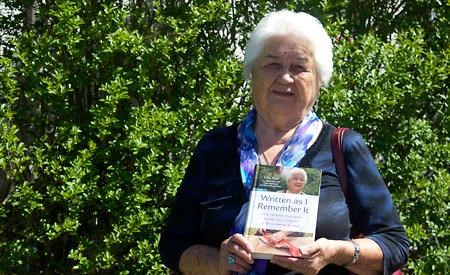Over 150 people packed into the Salish Centre at Tla’amin (Sliammon) Nation Saturday, May 24, for the launch of Elsie Paul’s recently published memoir.
Written as I Remember It: Teachings from the Life of a Sliammon Elder is not only the story of Paul’s life, it is a window on the Tla’amin people—who they are, where they live, the language they speak.
“I don’t profess to know everything in our history,” said Paul in an interview with the Peak. “I just want to see our history passed down—as much as I can remember.”
She was assisted in creating the book by many people from her granddaughter Harmony Johnson, Vancouver Island University regional campus principal Arlette Raaen and Paige Raibmon, who teaches First Nations history at the University of BC.
Paul has watched over the years as the number of Tla’amin elders has become fewer and fewer. She is concerned that without elders to pass on the language and their teachings, the culture will be in jeopardy.
“A lot of young people are aware of how things were from their own teachings from their own grandparents, however, it has never been recorded,” said Paul. “We’re losing those teachings and stories. I feel that by documenting what I remember I will be able to share with the young people and families and the rest of the people in our territory.”
Paul was raised by her grandparents and as a child only spent a short time in residential schools. Growing up provided her with access to stories about how life was before Europeans started to settle in the territory.
“It’s pretty much telling the story of my grandparents’ lives, the history of my family and other families who were close to me,” said Paul.
Another reason she felt compelled to write the book was to explain that Tla’amin Nation, despite being part of the Coast Salish group of peoples, had its own identity and traditional practices which makes it unique.
She had been thinking about the idea for the book for many years, but between raising a family and caring for elders, little time was left for making a record of her life and experiences.
She was given what she recalls “a nudge” about six years ago when after a funeral for a close family friend, Chris McNaughton asked her if anything about Tla’amin culture had been written down. When she said it hadn’t McNaughton suggested that his partner Arlette Raaen, who he knew had a lifelong interest in writing, could help.
“It was true, but I don’t know I would have just said it,” said Raaen. If he had not suggested her helping, “it could have been one of those moments that just passes.”
That summer Raaen and Paul worked intensively together on the book.
“She’d come over and we’d spend a half day together working on a whole section of the book,” said Raaen. “It was amazing to me how she just rolled it out. She’s got this natural storyteller instinct.”
There were many days, especially when the women talked about more difficult topics like residential schools and the grieving process, that helped them become close friends, said Raaen.
“It’s been one of the best opportunities of my life to get to do this work with Elsie,” she added.
The book will be widely available in the fall, but readers who are interested in obtaining a copy before then can contact Paul’s daughter Marlane Christensen by telephone 604.483.4138.



